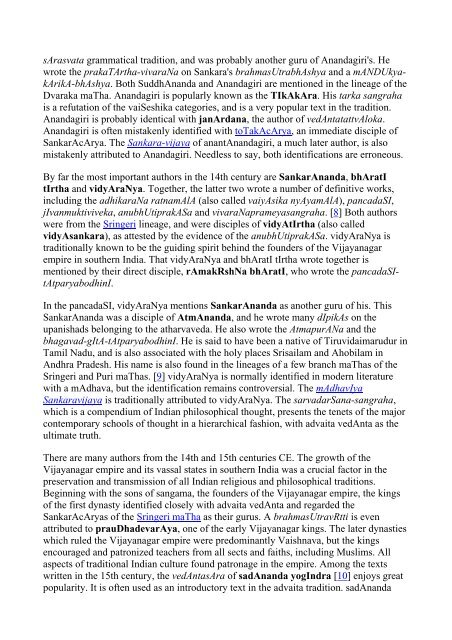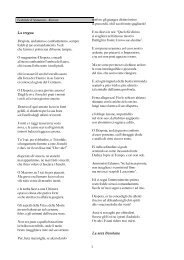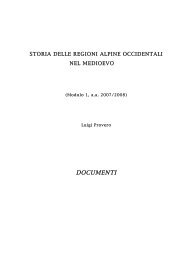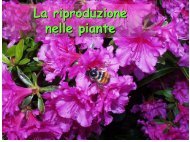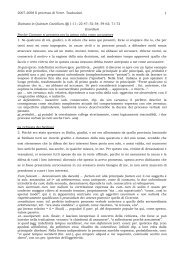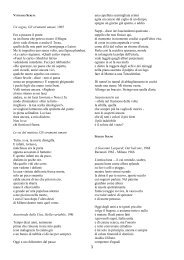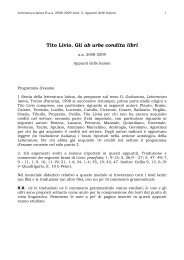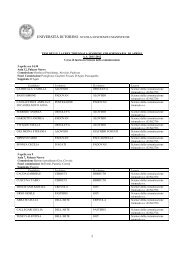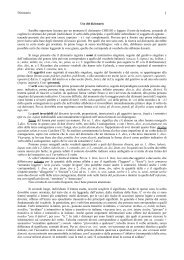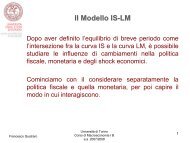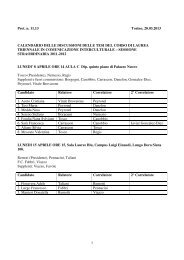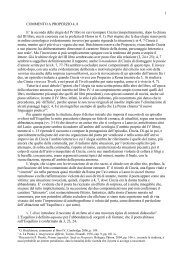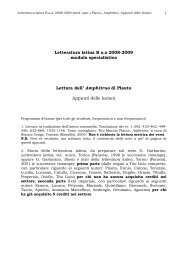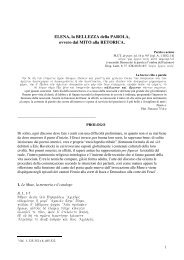ajAti vAda
ajAti vAda
ajAti vAda
You also want an ePaper? Increase the reach of your titles
YUMPU automatically turns print PDFs into web optimized ePapers that Google loves.
sArasvata grammatical tradition, and was probably another guru of Anandagiri's. He<br />
wrote the prakaTArtha-vivaraNa on Sankara's brahmasUtrabhAshya and a mANDUkyakArikA-bhAshya.<br />
Both SuddhAnanda and Anandagiri are mentioned in the lineage of the<br />
Dvaraka maTha. Anandagiri is popularly known as the TIkAkAra. His tarka sangraha<br />
is a refutation of the vaiSeshika categories, and is a very popular text in the tradition.<br />
Anandagiri is probably identical with janArdana, the author of vedAntatattvAloka.<br />
Anandagiri is often mistakenly identified with toTakAcArya, an immediate disciple of<br />
SankarAcArya. The Sankara-vijaya of anantAnandagiri, a much later author, is also<br />
mistakenly attributed to Anandagiri. Needless to say, both identifications are erroneous.<br />
By far the most important authors in the 14th century are SankarAnanda, bhAratI<br />
tIrtha and vidyAraNya. Together, the latter two wrote a number of definitive works,<br />
including the adhikaraNa ratnamAlA (also called vaiyAsika nyAyamAlA), pancadaSI,<br />
jIvanmuktiviveka, anubhUtiprakASa and vivaraNaprameyasangraha. [8] Both authors<br />
were from the Sringeri lineage, and were disciples of vidyAtIrtha (also called<br />
vidyAsankara), as attested by the evidence of the anubhUtiprakASa. vidyAraNya is<br />
traditionally known to be the guiding spirit behind the founders of the Vijayanagar<br />
empire in southern India. That vidyAraNya and bhAratI tIrtha wrote together is<br />
mentioned by their direct disciple, rAmakRshNa bhAratI, who wrote the pancadaSItAtparyabodhinI.<br />
In the pancadaSI, vidyAraNya mentions SankarAnanda as another guru of his. This<br />
SankarAnanda was a disciple of AtmAnanda, and he wrote many dIpikAs on the<br />
upanishads belonging to the atharvaveda. He also wrote the AtmapurANa and the<br />
bhagavad-gItA-tAtparyabodhinI. He is said to have been a native of Tiruvidaimarudur in<br />
Tamil Nadu, and is also associated with the holy places Srisailam and Ahobilam in<br />
Andhra Pradesh. His name is also found in the lineages of a few branch maThas of the<br />
Sringeri and Puri maThas. [9] vidyAraNya is normally identified in modern literature<br />
with a mAdhava, but the identification remains controversial. The mAdhavIya<br />
Sankaravijaya is traditionally attributed to vidyAraNya. The sarvadarSana-sangraha,<br />
which is a compendium of Indian philosophical thought, presents the tenets of the major<br />
contemporary schools of thought in a hierarchical fashion, with advaita vedAnta as the<br />
ultimate truth.<br />
There are many authors from the 14th and 15th centuries CE. The growth of the<br />
Vijayanagar empire and its vassal states in southern India was a crucial factor in the<br />
preservation and transmission of all Indian religious and philosophical traditions.<br />
Beginning with the sons of sangama, the founders of the Vijayanagar empire, the kings<br />
of the first dynasty identified closely with advaita vedAnta and regarded the<br />
SankarAcAryas of the Sringeri maTha as their gurus. A brahmasUtravRtti is even<br />
attributed to prauDhadevarAya, one of the early Vijayanagar kings. The later dynasties<br />
which ruled the Vijayanagar empire were predominantly Vaishnava, but the kings<br />
encouraged and patronized teachers from all sects and faiths, including Muslims. All<br />
aspects of traditional Indian culture found patronage in the empire. Among the texts<br />
written in the 15th century, the vedAntasAra of sadAnanda yogIndra [10] enjoys great<br />
popularity. It is often used as an introductory text in the advaita tradition. sadAnanda


